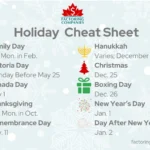The Art of Layering: A Practical Guide to Buying Quality Winter Clothing

Mastering the Cold: Your Practical Guide to Buying Quality Winter Clothing in Canada
For newcomers, the Canadian winter can be a formidable opponent. The key to not just surviving, but truly enjoying, the colder months lies in understanding the art of layering and investing in quality winter clothing. This isn't just about staying warm; it's about staying comfortable, dry, and safe. This practical guide will break down the layering system, essential materials, and where to find the best winter gear in Canada.
The Layering System: Your Best Defense
The most effective way to dress for Canadian winter is by using a three-layer system. This allows you to trap warm air and adjust your clothing based on temperature fluctuations and activity levels.
 The Age of Majority in Each Canadian Province and What It Means for You
The Age of Majority in Each Canadian Province and What It Means for You1. Base Layer (Wicking Layer)
- Purpose: To wick moisture (sweat) away from your skin. If sweat stays on your skin, it will make you feel cold.
- Materials: Look for merino wool or synthetic fabrics like polyester or polypropylene.
- Avoid: Cotton. It absorbs moisture and dries slowly, making you feel colder.
- Examples: Long-sleeved shirts and long underwear (often called "thermals").
2. Mid-Layer (Insulating Layer)
- Purpose: To provide warmth by trapping body heat.
- Materials: Fleece, down (for very cold, dry conditions), or synthetic insulation.
- Examples: Fleece jacket, down vest, or a thick wool sweater.
3. Outer Layer (Protective Shell)
- Purpose: To protect you from wind, snow, and rain. This layer should be waterproof and windproof.
- Materials: Gore-Tex, eVent, or other similar breathable, waterproof fabrics.
- Examples: A heavy winter coat or parka. Look for one that is rated for the temperatures you expect (e.g., -20°C, -30°C).
Essential Winter Gear: Beyond the Layers
Beyond your core clothing, several accessories are non-negotiable for staying warm and safe.
1. Winter Coat/Parka
This is your most important investment. Look for:
 Statutory Holidays in Canada: Which Days Are Off and How You Should Be Paid
Statutory Holidays in Canada: Which Days Are Off and How You Should Be Paid- Insulation: Down (higher fill power means warmer) or synthetic.
- Waterproof/Windproof: Essential for protection from snow, sleet, and wind.
- Hood: A well-insulated hood, preferably with a fur trim (real or synthetic), helps protect your face from windburn.
- Length: Longer coats (parkas) offer more coverage.
2. Winter Boots
Your feet are highly susceptible to cold. Look for boots that are:
- Waterproof: To keep your feet dry from snow and slush.
- Insulated: Look for a temperature rating (e.g., rated to -30°C).
- Good Grip: With deep, aggressive treads to prevent slipping on ice and snow.
- Size: Buy a size larger to accommodate thick wool socks.
3. Hats, Gloves/Mittens, and Scarves
- Hats: A warm, insulated hat that covers your ears is crucial, as significant body heat is lost through the head.
- Gloves or Mittens: Mittens are generally warmer than gloves. Look for waterproof and insulated options.
- Scarves/Neck Gaiters: A thick wool or fleece scarf will protect your neck and lower face from the cold wind.
4. Wool Socks
Merino wool socks are excellent for warmth and wicking away moisture, keeping your feet dry and comfortable. Avoid cotton socks in winter.
 The Unwritten Rules of Tipping in Canada: A Guide for Every Situation
The Unwritten Rules of Tipping in Canada: A Guide for Every Situation5. Ice Grips (Optional but Recommended)
These attach to your boots and provide extra traction on icy sidewalks, significantly reducing the risk of falls.
Where to Buy Quality Winter Clothing in Canada
You don't need to break the bank to get good winter gear. Look for sales at:
 The Hidden Gem of Integration: Why You Should Join Your Local Community Centre
The Hidden Gem of Integration: Why You Should Join Your Local Community Centre- Outdoor Retailers: MEC (Mountain Equipment Company), Atmosphere, Sport Chek. These stores specialize in outdoor gear and have knowledgeable staff.
- Department Stores: Hudson's Bay, Simons, Nordstrom (for higher-end options).
- Discount Retailers: Winners, Marshalls, TJX Maxx can offer good deals on brand-name items.
- Second-Hand Stores: For budget-friendly options, check local thrift stores or online marketplaces like Kijiji or Facebook Marketplace, especially for mid-layers and accessories.
Pro Tip: Buy your winter gear during end-of-season sales (February/March) for the best discounts.
Conclusion: Embrace the Canadian Winter
Your first Canadian winter might seem intimidating, but with the right clothing and a few practical tips, you'll be well-prepared to face the cold. Embrace the unique beauty of the season, try new winter activities, and you'll soon find yourself enjoying this integral part of the Canadian experience. Investing in quality winter clothing is an investment in your comfort and well-being.

Related content